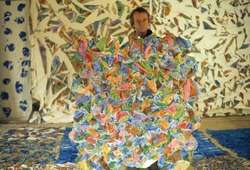Simon Hantaï
Simon Hantaï (7 December 1922, Biatorbágy, Hungary – Paris, 12 September 2008;[1] took French nationality in 1966) is a painter generally associated with abstract art.

Biography
After studying at the Budapest School of Fine Art, he traveled through Italy on foot and moved to France in 1948. André Breton wrote the preface to his first exhibition catalogue in Paris, but in 1955 Hantaï broke with the surrealist group over Breton's refusal to accept any similarity between the surrealist technique of automatic writing and Jackson Pollock's methods of action painting.
A retrospective of his work was held at the Centre Pompidou in 1976, and in 1982 he represented France at the Venice Biennale.[2]
A representative collection of Hantaï's works is held at the Musée National d'Art Moderne, Centre Georges Pompidou, Paris, and at the Musée d'Art Moderne de la Ville de Paris.
A Simon Hantaï Retrospective opened at the Centre Pompidou on May 22, 2013 with more than 130 works from 1949 to 1990s, and a full color illustrated catalog.
His sons are the musicians Marc, Jérôme and Pierre Hantaï.
The folding method
In 1960, Hantaï developed his technique of "pliage" (folding): the canvas is first folded in various forms, then painted with a brush, and unfolded, leaving apparent blank sections of the canvas interrupted by vibrant splashes of color. From 1967 to 1968 he worked on the Meuns series where he studies the theme of the figure. Meun is the name of a small village in the Forest of Fontainebleau where the artist lived starting 1966. Hantaï stated: "It was while working on the Studies that I realized what my true subject was - the resurgence of the ground underneath my painting."[3] In contrast with the Meun (1967-68), the figure, in the Studies (1969), is absorbed and the white detaches from being the background and becomes dynamic.
Mariales (Cloaks) (1960–62) Meuns (1967–68) Etudes (Studies) (1969) Blancs (the Whites) (1973–74) Tabulas (from 1974) Laissées (Leftovers)(1981–1994)
References
- Décès du peintre Simon Hantaï Archived 2008-09-18 at the Wayback Machine Le Figaro, 15 September 2008
- Tom McDonough, Hantai's Challenge to Painting, Art in America, March 1999. Archived 2008-03-14 at the Wayback Machine
- Carter Ratcliff, Hantaï in America, 2006. Archived 2017-04-12 at the Wayback Machine Quote from Hantaï in conversation with Paul Rodgers, Paris studio, 1994
Selected bibliography
- New York Times Obituary of Simon Hantaï
- Rosenberg, Karen, "Art in Review: Simon Hantaï," The New York Times, 5/23/13.
- Rodgers, Paul, "Simon Hantaï & Andy Warhol - The Fate of Modern Art in the Post-Second World War Era" 4/1/10.
- Rodgers, Paul, “The Resurgent Ground: Simon Hantaï,” The Modern Aesthetic, 2017.
- Cochran, Samuel, "Simon Hantaï's Abstract Paintings At Paul Kasmin Gallery, Centre Pompidou," Architectural Digest, 5/7/13.
- "Simon Hantaï," Time Out New York, 4/24/13.
- Ostrow, Saul, "Reviews: Simon Hantaï," Art in America, 9/11/11.
- An essay on Hantaï by art historian Molly Warnock
- Warnock, Molly. Simon Hantaï and the Reserves of Painting. Pennsylvania State University Press, 2020.[1]
- An essay on Hantaï by Ben Lerner
- Dominique Fourcade, Isabelle Monod-Fontaine, Alfred Pacquement, Jean Coyner. Simon Hantaï, Paris: Centre Pompidou, 2013.
- Archives Simon Hantaï
- "Books - Simon Hantaï and the Reserves of Painting". Penn State University Press. Retrieved 1 July 2020.